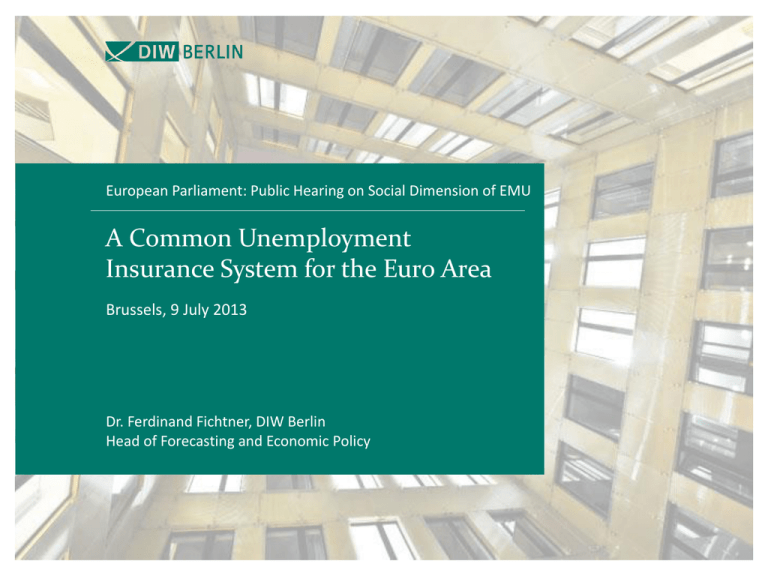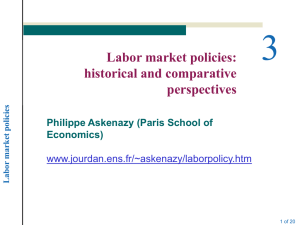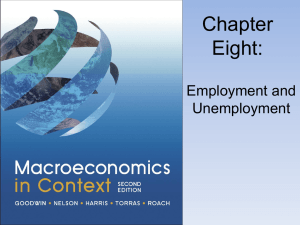Ferdinand Fichtner - European Unemployment Insurance
advertisement

European Parliament: Public Hearing on Social Dimension of EMU A Common Unemployment Insurance System for the Euro Area Brussels, 9 July 2013 Dr. Ferdinand Fichtner, DIW Berlin Head of Forecasting and Economic Policy Do We Need a European Transfer Mechanism? • Thereby: Higher investment activity (risk aversion) and reduced structural labour market problems (hysteresis) 2 0 Source: European Central Bank, DIW calculations. Taylor rate = 1 + 1,5*inflation + employment gap. A Common Unemployment Insurance System for the Euro Area as Automatic Transfer Mechanism Ferdinand Fichtner - 09.07.2013 2012 2011 2010 -2 2009 Fiscal transfer mechanism reduces economic volatility and makes a more appropriate monetary policy possible 4 2008 • Result: Incentive problem (domestic costs but benefits partially in partner countries) and potential magnification of business cycles 6 2007 • High degree of trade integration leads to a leakage of fiscal stimulus to neighbouring countries 8 2006 • Taylor rule periphery Taylor rule Germany 2005 Additional Problem: reduced attractiveness of national fiscal policy 10 2004 Inflationary pressure, overheating, creation of bubbles; too restrictive monetary policy for weak countries 2003 • ECB Main Refinancing Rate Taylor rule core 2002 Result: business cycles are magnified 2001 • Money and Inflation (ratio; % y-o-y) 2000 • Common monetary policy cannot account for asymmetric business cycles 1999 • Calculating the Output Gap for Transfers is Problematic • • Classical approach: Fiscal transfers as function of the output gap Drawbacks: • Methodological uncertainties in calculating the growth potential and output gap • Transfers are not compulsory and/or do not affect demand quickly enough • In political practice, adopted support measures are not reversed once economic situation changes • • Output gap estimates over time (% of Potential GDP) 4 Political support is uncertain Automatic transfer mechanism in the form of an unemployment insurance largely avoids these problems Germany 3 2 1 0 -1 -2 -3 -4 -5 -6 2001 2002 2003 2004 2005 2006 2007 2008 2009 2010 2011 2012 Source: OECD Economic Outlook, several issues. Last observation: 2012. A Common Unemployment Insurance System for the Euro Area as Automatic Transfer Mechanism Ferdinand Fichtner - 09.07.2013 Calculating the Output Gap for Transfers is Problematic • • Classical approach: Fiscal transfers as function of the output gap Drawbacks: • • • • • Output gap estimates over time (% of Potential GDP) 4 Methodological uncertainties in calculating the growth potential and output gap Transfers are not compulsory and/or do not affect demand quickly enough In political practice, adopted support measures are not reversed once economic situation changes Political support is uncertain Automatic transfer mechanism in the form of an unemployment insurance largely avoids these problems Spain 2 0 -2 -4 -6 -8 -10 2001 2002 2003 2004 2005 2006 2007 2008 2009 2010 2011 2012 Source: OECD Economic Outlook, several issues. Last observation: 2012. A Common Unemployment Insurance System for the Euro Area as Automatic Transfer Mechanism Ferdinand Fichtner - 09.07.2013 Alternative: European Unemployment Insurance System Basic idea: • • • Quick automatic transfer mechanism analogous to automatic stabilizer Transfer of funds without econometric calculations and much political discretion Characteristics: • Employees pay a part of their wages into a European UIS and would receive compensation payments from this fund in the event of unemployment • Duration of payments would only cover short term unemployment (e.g. one year max) • Relatively low transfer payments (“lowest common denominator”) that can be combined with national payments Diagram of a European Unemployment Insurance System (% of previous disposable income) 70 60 50 National insurance benefits 40 30 20 European unemployment insurance 10 0 12 • Month in unemployment Source: Dullien and Fichtner (2012; 2013). A Common Unemployment Insurance System for the Euro Area as Automatic Transfer Mechanism Ferdinand Fichtner - 09.07.2013 Advantages of a European Unemployment Insurance • Automatic stabiliser: • • Economic upturn: reduced purchasing power of the country Unemployment rates in Europe (ppt. deviation from euro area average) Germany Economic downturn: increased purchasing power of the country 15 • Strong correlation between short term unemployment and business cycle 10 • Transfer payments immediately affect demand 5 • No additional burdens: European UIS replaces part of national insurance systems 0 • Low bureaucratic burden, high transparency • Controllable incentive effects : • • Incentives for the unemployed to look for a new job do not change as payments from the new unemployment insurance replace domestic transfers Countries remain responsible for longterm unemployment , no incentive for governments to reduce reform efforts France Italy Spain Netherlands -5 -10 2001 2003 Source: Eurostat. Last observation: May 2013 A Common Unemployment Insurance System for the Euro Area as Automatic Transfer Mechanism Ferdinand Fichtner - 09.07.2013 2005 2007 2009 2011 2013 Problems of a European Unemployment Insurance • • • • Unemployment rates in Europe Risks High payments during the introduction of European UIS could reduce the willingness to reform labour market Permanent transfers between countries cannot completely be precluded (ppt. deviation from euro area average) Germany France Italy Spain Netherlands 15 10 Further limitations • Functioning automatic stabilisers on national level would make European UIS redundant – but do they work? • No solution for structural asymmetries between member states (e.g. wage negotiating systems, competitiveness, labour market regulation) 5 0 -5 -10 2001 2003 Source: Eurostat. Last observation: May 2013 A Common Unemployment Insurance System for the Euro Area as Automatic Transfer Mechanism Ferdinand Fichtner - 09.07.2013 2005 2007 2009 2011 2013 Source Sebastian Dullien and Ferdinand Fichtner (2013), A Common Unemployment Insurance System for the Euro Area, in: DIW Economic Bulletin 1/2013. https://www.diw.de/sixcms/detail.php?id=diw_01.c.413722.de A Common Unemployment Insurance System for the Euro Area as Automatic Transfer Mechanism Ferdinand Fichtner - 09.07.2013 Thank you for your attention. Dr. Ferdinand Fichtner, ffichtner@diw.de DIW Berlin — Deutsches Institut für Wirtschaftsforschung e.V. Mohrenstraße 58, 10117 Berlin www.diw.de








